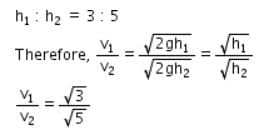MCQ: Equations of Motion - Class 9 MCQ
10 Questions MCQ Test Science Class 9 - MCQ: Equations of Motion
A man is moving with 36 kmph. The time of reaction is 0.9 seconds. On seeing an obstacle in the path, he applies brakes and decelerates at 5 m/s2, the total distance covered before he stops is:
The ratio of the heights from which two bodies are dropped is 3:5 respectively. The ratio of their final velocities is:
A body starts to slide over a horizontal surface with an initial velocity of 0.2 m/s. Due to friction, its velocity decreases at the rate of 0.02 m/s2. How much time will it take for the body to stop?
If you whirl a stone on the end of the string and the string suddenly breaks, the stone will:
The time taken by a train to slow down from 80 kmh-1 to 20 kmh-1 with a uniform deceleration of 2 ms-2 is
A racing car has a uniform acceleration of 6 m/s2. In 10s it will cover:
A body performs an accelerated motion, with uniform speed. The motion of body is
Which of the following is the correct formula for the distance traveled by an object in uniform motion?
|
88 videos|369 docs|67 tests
|





















